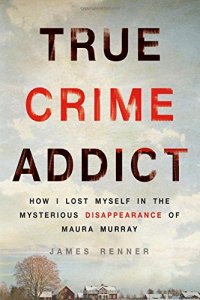Crime fiction – and fact – in the New York Times
A special issue of the July 31 edition of The New York Times Book Review – “Summer Thrills” – was fairly bursting with great suggestions for us crime fiction fans. And there was even a two page spread allotted to true crime! The writer was none other than the paper’s long time mystery reviewer (and taste maker for many of us), Marilyn Stasio.
Before plunging into specifics, Stasio admits that “…true crime unnerves me. It’s so…real.” Well of course it is! (I found this confession rather endearing.) But plunge ahead she does, to the tune of six different titles. There’s a nice variety here: contemporary, historical, a visit to the morgue, obsession with a rare tropical fish (the Asian arowana), etc.
 I’ve read two of the six: True Crime Addict and The Wicked Boy. In a way, they represent the extremes of true crime writing. In the first, journalist James Renner recounts his obsessive search for Maura Murray. On February 9 2004, while standing beside her disabled vehicle in Haverhill, New Hampshire, Murray went missing. Between the time she was spotted by a passerby who offered to help, and seven minutes later when the police arrived, she had disappeared. Just like that. One minute she was there; the next, she was gone.
I’ve read two of the six: True Crime Addict and The Wicked Boy. In a way, they represent the extremes of true crime writing. In the first, journalist James Renner recounts his obsessive search for Maura Murray. On February 9 2004, while standing beside her disabled vehicle in Haverhill, New Hampshire, Murray went missing. Between the time she was spotted by a passerby who offered to help, and seven minutes later when the police arrived, she had disappeared. Just like that. One minute she was there; the next, she was gone.
She has not been seen or heard from since.
Renner’s determination to solve this mystery is impressive. He conducted many interviews, reviewed a great deal of evidence, and in general worked tirelessly. This is an unusual true crime narrative, though, in the sense that the writer/investigator keeps getting in his own way. There’s a definite manic aspect to this quest that seems to take root in an already volatile personality. It probably didn’t help that after taking the Minnesota Multiphasic Personality Inventory, he was informed by the psychologist that “‘Your results were very similar to those of Ted Bundy, the serial killer.'”
After this bomb is dropped, Renner comments: “That’s one of those statements you just can’t unhear.” (It turns out that hard charging individuals such as law enforcement officers and CEO’s tend to score in a similar range.)
Sometimes the prose gets a bit ragged around the edges, but the book is never dull. In fact, there are times when Renner’s observations are striking. At one point, he hikes an area near where Maura disappeared. It’s treacherous going, and icy to boot. When he finally gets back to his vehicle, he’s tearful, exhausted, and drenched in sweat.
We forget how dangerous nature can be. We want to forget, I think. We don’t want to be reminded that nature is more deadly than man. Man can be cruel, but nature is indifferent. It is the unrivaled psychopath.
Throughout this book, the author veers from intense concentration on the task at hand to a self-absorption that’s almost as intense. He’s married with children; they must perforce go along with him on this wild ride. (The term I’d use to describe his wife Julie is ‘long suffering.’) Renner’s taking – or not taking – the drug Cymbalta is a thread that runs through this story. He’s grateful for the calming affect it has on him. On the other hand: “…there’s a freedom in blind rage once you give yourself over to it that is as welcoming as any drug.” At one point, he gives himself over to it in court and as a result, lands in jail.
I actually had trouble putting this book down. I might even read it again.
*****************************
 Kate Summerscale is the author of the terrific Victorian true crime narrative, The Suspicions of Mr Whicher (2008). In my view, The Wicked Boy is just as good, perhaps even better. It deserves a review of its own, and will get it in this space, soon.
Kate Summerscale is the author of the terrific Victorian true crime narrative, The Suspicions of Mr Whicher (2008). In my view, The Wicked Boy is just as good, perhaps even better. It deserves a review of its own, and will get it in this space, soon.


Leave a comment